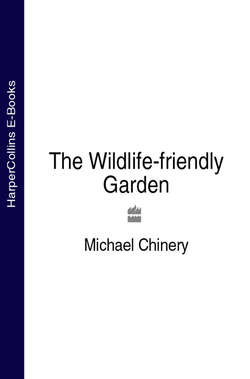Читать книгу The Wildlife-friendly Garden - Michael Chinery - Страница 6
ОглавлениеAlthough I have referred to the garden as a single habitat, on a par with a woodland or a meadow, most gardens are really very complex mixtures of habitats, each supporting its own rich assemblage of plant and animal life.
Flower beds
The flower border, a major feature of most gardens, contains a wide range of plants that flower at different times and attract insects and other small creatures for much of the year. Caterpillars chew the leaves, bugs suck the sap, bees and butterflies feast on the nectar, and many other insects attack the fruits and seeds. Hidden from view, the roots also provide sustenance for wireworms, leatherjackets, slugs, millipedes and numerous other creepy-crawlies, while earthworms derive most of their nourishment from the decaying plant matter in the soil. All of these small creatures provide food for birds and small mammals, so even a very simple flower border is really a mixture of several micro-habitats.
Michael Chinery
Even the smallest of backyards can be a riot of colour, packed with flowers that act as filling stations for butterflies and many other insects.
Michael Chinery
Tiny mosses, seen here covered with pear-shaped spore capsules, erupt from the smallest cracks in walls and paths.
Vegetable plots
The vegetable plot has a similar diversity, although it does not have much in the way of nectar sources and, being subject to more disturbance as crops are planted and harvested, it tends to support a smaller variety of animal life in general.
Trees, shrubberies and hedges
These lend welcome shade and shelter to other parts of the garden and are micro-habitats in their own right, providing homes and hunting grounds for insects, spiders, birds and many other creatures.
Walls, fences and paths
CONSERVATION TIP
If you find a strange creature in your garden, don’t assume it is harmful. Before squashing it with your foot, try to find out what it is and what it does. You will probably find that it is harmless or even useful – and then you won’t need to squash it!
These provide yet more living space for both flora and fauna, a fact that is easily appreciated when you look at the number of spider webs that adorn the fences in the autumn. Even concrete paths can support wildlife, tiny mosses wedge themselves into cracks in the concrete, while ants often nest underneath the paths and benefit from the heat absorbed by the concrete on sunny days – although you might not know that they are there until they fly off on their marriage flights in the summer.
Garden ponds
A pond is one of the richest of all wildlife habitats, and garden ponds are, happily, becoming increasingly popular. Pond-watching can be great fun, and the garden pond can literally be a life-saver for frogs, toads and dragonflies, all of which are now suffering from the disappearance of so many farm ponds and other watery sites in the countryside.
Michael Chinery
Hit by the disappearance of so many farm and village ponds, many frogs find refuge in our garden ponds and mop up the slugs in return for the hospitality.
Go for variety
Not all of the visitors to your garden will be welcome guests, of course, but they will all add to the richness of the garden and the great majority will do no harm. They are just using your garden as a home. The more habitats you can create in your garden, the more guests you are likely to get, and the more diversity of wildlife. This can only be good for the wildlife population as a whole.
Michael Chinery
A single climbing rose can feed a huge number of insects, which, in turn, can provide food for numerous spiders and birds. The birds may also nest there, well protected from predators by the rose’s prickly stems.
